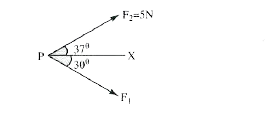From Newton's second law of motion, it can be inferred that
No force is required to move a body uniformly along straight line
Accelerated motion is always due to an external force
Inertial mass of a body is equal to force required per unit acceleration in the body
All of these
To solve the question regarding Newton's second law of motion, we will analyze each of the given options step by step.
1. Understanding Newton's Second Law:
Newton's second law states that the acceleration of an object is directly proportional to the net external force acting on it and inversely proportional to its mass. Mathematically, it can be expressed as:
Fnet=m⋅a
where Fnet is the net external force, m is the mass of the object, and a is the acceleration.
2. Analyzing Option A:
- Statement: "No force is required to move a body uniformly along a straight line."
- Explanation: If a body is moving uniformly along a straight line, it means that its velocity is constant, and hence its acceleration is zero. According to Newton's second law, if a=0, then Fnet=m⋅0=0. Therefore, no net external force is required to maintain this state of motion.
- Conclusion: Option A is correct.
3. Analyzing Option B:
- Statement: "Accelerated motion is always due to an external force."
- Explanation: For an object to accelerate, there must be a net external force acting on it. According to the equation Fnet=m⋅a, if a is not zero, then Fnet must also be non-zero. Thus, accelerated motion cannot occur without an external force.
- Conclusion: Option B is correct.
4. Analyzing Option C:
- Statement: "Inertial mass of a body is equal to the force required per unit acceleration of the body."
- Explanation: Rearranging the equation Fnet=m⋅a gives us:
m=Fneta
This shows that the inertial mass m is indeed equal to the net external force divided by the acceleration. Therefore, this statement is true.
- Conclusion: Option C is correct.
5. Final Conclusion:
Since all three options (A, B, and C) are correct based on the analysis of Newton's second law of motion, we conclude that the answer to the question is that all options are valid inferences from Newton's second law.
Newton's second law states that the acceleration of an object is directly proportional to the net external force acting on it and inversely proportional to its mass. Mathematically, it can be expressed as:
Fnet=m⋅a
where Fnet is the net external force, m is the mass of the object, and a is the acceleration.
- Statement: "No force is required to move a body uniformly along a straight line."
- Explanation: If a body is moving uniformly along a straight line, it means that its velocity is constant, and hence its acceleration is zero. According to Newton's second law, if a=0, then Fnet=m⋅0=0. Therefore, no net external force is required to maintain this state of motion.
- Conclusion: Option A is correct.
- Statement: "Accelerated motion is always due to an external force."
- Explanation: For an object to accelerate, there must be a net external force acting on it. According to the equation Fnet=m⋅a, if a is not zero, then Fnet must also be non-zero. Thus, accelerated motion cannot occur without an external force.
- Conclusion: Option B is correct.
- Statement: "Inertial mass of a body is equal to the force required per unit acceleration of the body."
- Explanation: Rearranging the equation Fnet=m⋅a gives us:
m=Fneta
This shows that the inertial mass m is indeed equal to the net external force divided by the acceleration. Therefore, this statement is true.
- Conclusion: Option C is correct.
Since all three options (A, B, and C) are correct based on the analysis of Newton's second law of motion, we conclude that the answer to the question is that all options are valid inferences from Newton's second law.
Topper's Solved these Questions
- LAWS OF MOTIONBOOK - AAKASH INSTITUTE ENGLISHCHAPTER - LAWS OF MOTIONEXERCISE - Assignment (SECTION-B)
44 Videos
- LAWS OF MOTIONBOOK - AAKASH INSTITUTE ENGLISHCHAPTER - LAWS OF MOTIONEXERCISE - Assignment (SECTION-C)
63 Videos
- LAWS OF MOTIONBOOK - AAKASH INSTITUTE ENGLISHCHAPTER - LAWS OF MOTIONEXERCISE - EXERCISE
69 Videos
- KINETIC THEORYBOOK - AAKASH INSTITUTE ENGLISHCHAPTER - KINETIC THEORYEXERCISE - EXERCISE (ASSIGNMENT) SECTION - D Assertion - Reason Type Questions
10 Videos
- MAGNETISM AND MATTER BOOK - AAKASH INSTITUTE ENGLISHCHAPTER - MAGNETISM AND MATTER EXERCISE - ASSIGNMENT (SECTION D)
26 Videos
Similar Questions
Knowledge Check
Newton's second law of motion is
AF=dpdtBF=mvCF=mv2DF=m2vNewton's third law :
Adefines the force qualitativelyBdefines the force quantitativelyCexplains the way a force acts on a bodyDgives the direction of force.
State Newton's third law of motion.
View SolutionNewton's II law of motion connects:
View SolutionAssertion: Newton's second law of motion gives the measurement of force.
Reason: According to Newton's second law of motion, force is directly proportional to the rate of change of momentum.
View SolutionAccording to Newton.s second law of motion, resultant force on a particle is in the direction of acceleration of the particle. Two forcce F1andF2 are acting on a particle as shown in the figure. The acceleration of the particle is along X-axis. FInd the value of F1 (in newton)

View SolutionFor rotational motion, the Newton's second law of motion is indicated by :-
View SolutionHow does Newton's second law of motion differ from first law of motion ?
View Solution
